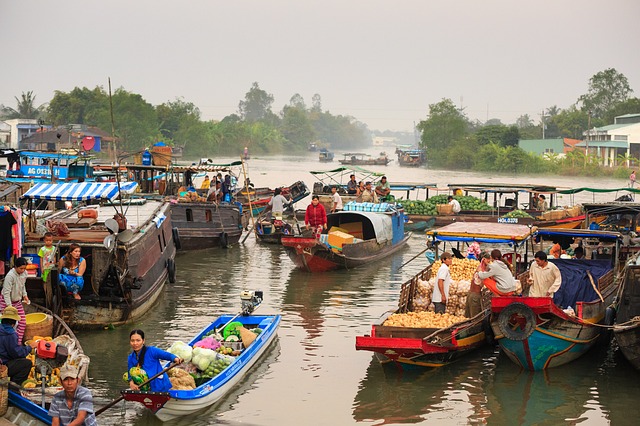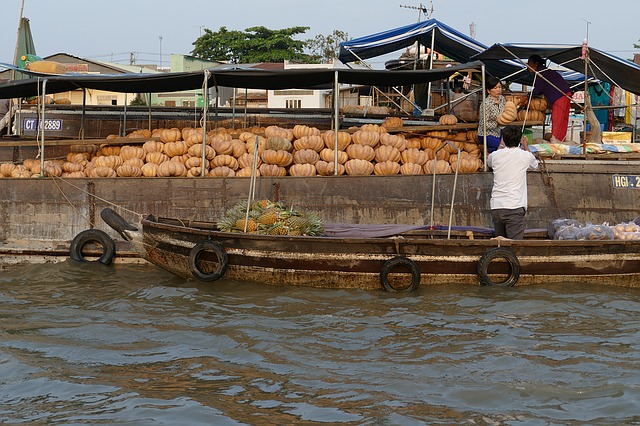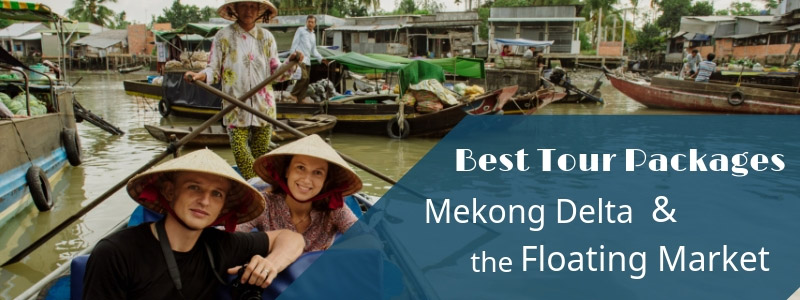Besides the prominent three regions, namely the Northern, the Middle, and the Southern, Vietnam features other smaller areas with particular characteristics. One of them is the West region, which situates in the southwest of Southern Vietnam.
The fertile West with interlocking waterways is a magnet for tourism thanks to the vibrant floating market on the Mekong river. Not only the large paddy fields, vast melaleuca forests or the productive rivers carrying heavy silt, but tourists on a cruise to the floating markets on the West also have a chance to look closely into the life of the locals. The experience of those who rarely leave their boats.
How To Get A Perfect Floating Market Trip In Vietnam
Pick The Best Time To Visit Floating Markets On The West Of Vietnam
Floating markets on the West of Vietnam is set on the downstream of the significant Mekong River. There are two main seasons here:
- The dry season begins from around November and ends around April to May next year. The temperature in this time of the year is quite high at around 28°C.
- The rainy season is from May to October. Rain is dramatic, but it does not last for too long, which makes the weather super humid.
- There is another flooding season in Vietnam from September to November when the river water level rises slowly. The locals have well adopted with this strange season while tourists consider it a unique thing of Mekong River delta in Vietnam. Therefore, if the South of Vietnam is the main stop in your Mekong cruise, come and join a tour in the strange flooding season.
The length of your stay depends much on your choice of destinations. The West region contains up to 12 provinces; each features unique floating markets. The thing is, not all of them are easy to access or friendly to international visitors. Most of the dialects in the West are hard to learn, and the native people don’t speak much English. As a result, we highly recommend you visit some popular markets (you will find the list down below) where English speaking guides are available.

Not all of the floating markets in Mekong Delta are easy to access or friendly to international visitors. Photo: Quang Nguyen vinh/Pixabay
If you don’t have much time, you can choose a day trip to catch the vibe of the West region from Ho Chi Minh city. Still, the ideal length of stay is around 2 to 3 days as the Mekong river cruise is such an exotic experience. Spending one night onboard helps you gain a comprehensive view of the local life. How they manage their life after dark. How early they have to get up to prepare for the floating markets. You will know on an overnight cruise on Mekong River.
What To Pack For A Floating Market Voyage?
When starting your trip, moderate luggage is the best. The weather is mostly pleasant, so comfortable clothes like T-shirts, tank tops, shorts are really suitable. Don’t forget to wear sneakers. It is of more considerable help when you go from boats to boats in order to see the goods.
In case the sun is too fierce, also bring a light jacket to avoid sunburn. Moreover, as you will move a lot, remember to refill your water bottle to keep hydrated during the journey. If you have your laptop, smartphone, or camera alongside, the best way to keep these digital devices safe is to put them into a waterproof bag. You are traveling on the water, so be careful with your precious belongings. Another small but powerful thing for international guests is insect repellent to guard you against the insect bite and enjoy a comfortable trip.
Top 5 Floating Markets To Visit In Vietnam
Tan Chau (An Giang Province)
Mekong river first comes to Vietnam in Tan Chau, An Giang. It is famous for deep black silk dyed with the berries from the Diospyros Mollis (ebony tree). Another delicacy of Tan Chau is floating fish farms of about 140,000 red tilapia fish with high nutrition and flavourful taste.
Cai Rang (Ben Tre Province)
Cai Rang Floating Market is located on Cai Rang River, near Cai Rang Bridge, about 6km from the center of Can Tho city and 30 minutes by boat from Ninh Kieu Port. This is one of the most popular floating markets in the Mekong Delta, which is also a favorite place for many tourists. It specializes in trading fruits and specialties of the Mekong Delta.
However, the thing we appreciate most about Cai Rang is during your voyage; you may see local farmers working their fields by hand. They always wear traditional conical hats made of palm leaves. Some dress in the conventional costumes of the West called Ao ba ba. It is such a perfect way to explore Mekong citizens’ lifestyle.
You can also try to ride motorboats nearby Cai Rang floating market. The price for a speedboat to visit the market is 20,000 VND per capita (less than ten bucks).

Cai Rang is the most famous floating market in Mekong Delta. Photo: Jason Kucherawy/Pixabay
Sa Dec (Dong Thap Province)
Famous for lively floating markets, Sa Dec is where you can find the most indigenous yet exotic things. Have you ever imagined to eat rats (served fried), snakes, frogs, snails, and duck embryos?
If this kind of specialties is too much, there are still plenty of traditional Vietnamese foods such as bun Rieu cua, hu tieu (cooked in Southern style) and hundreds of tropical treasures.
Cai Be (Tien Giang Province)
If Sa Dec has vibrant markets with a lot of exotic things, floating markets in Cai Be is the most dynamic in the southwest countryside of the Mekong Delta because of the volume of exchanged goods.
Cai Be Floating Market is a floating market in Tan Phong islet right on the vast Tien River. This is one of the attractive destinations in Tien Giang visited by both domestic and international travelers. A distinctive feature of Cai Be is 24 hour working time. So it is very convenient for visitors to visit.
Cai Be floating market meets very early. From about 3 to 4 am saw boats everywhere flocking to the busiest. And when the sun appears, about 5 to 6 am, the market reaches the maximum volume of trading. This is an appropriate time for visitors to see the productive activities of Cai Be and the colorful life of the locals. Still, if you prefer quiet and peaceful, you should visit the floating market in the afternoon, at about 4 pm. When the sun is less fierce, the trading is less lively.

Tra On (Vinh Long Province)
Tra On the floating market in Tra On district, Vinh Long province, is the very last floating market on the Hau River, one in the two branches of the Mekong to flow across Vietnam before pouring into the East Sea. This is an old market associated with many cultural features of the Mekong Delta.
Tra On floating market operates all day. The busiest time is in the morning, from 5–6 am onwards. The most traded goods in Tra On are fruits, from ordinary tropical fruits such as bananas, guavas, tangerines, oranges … to more expensive fruits such as durian, mangosteen, mango, crock, orange, grapefruit … All can be found easily.





Comments